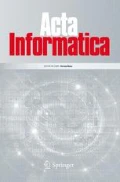Abstract
The main problem tackled in this paper is that of finding each set in a given collection that has no proper subset in the collection. Starting with a solution that uses a quadratic (in the size of the collection) number of subset tests, solutions are developed that are opportunistic in the sense of running significantly faster for certain classes of input (such as when most sets are small), but without running slower on other input. They are based on an opportunistic algorithm for the fundamental problem of finding an element common to two ordered sequences. Methodological issues are emphasized throughout.
Similar content being viewed by others
References
Aho, A.V., Hopcroft, J.E., Ullman, J.D.: The design and analysis of computer algorithms. Reading, MA: Addison-Wesley 1974
Dijkstra, E.W.: Smoothsort, an alternative for sorting in situ. Sci. Comput. Program.1, 223–233 (1982)
Dijkstra, E.W.: The saddleback search. Epistle EWD 934, Department of Computer Sciences, The University of Texas at Austin, September 1985
Dijkstra, E.W.: Fillers at the YoP Institute, in: The formal development of programs and proofs, E. W. Dijkstra (ed.), pp. 209–227. Reading,, MA: Addison-Wesley 1989
Dijkstra, E.W.: To hell with “meaningful identifiers” ! Epistle EWD 1044, Department of Computer Sciences, The University of Texas at Austin, February 1989
Dijkstra, E.W., Feijen, W.: The linear search revisited. Struct. Program.10, 5–9 (1989)
Dromey, R.G.: Forced termination of loops. Software: Pract. Exper.15, 30–40 (1985)
Gries, D.: The science of programming, Berlin Heidelberg New York: Springer 1981
Kirkpatrick, D, Seidel, R.: The ultimate planar convex hull algorithm? Technical Report 83-577. Department of Computer Science, Cornell University, 1983
Pritchard, P.: Algorithms for finding matrix models of propositional calculi. J. Autom. Reasoning (to appear)
Pritchard, P.: Another look at the “longest ascending subsequence” problem. Acta Inf.16, 87–91 (1981)
Pritchard, P.: Linear prime-number sieves: A family tree. Sci. Comput. Program.9, 17–35 (1987)
Pritchard, P.: An introduction to programming using Macintosh Pascal Reading, MA: Addison-Wesley 1988
Author information
Authors and Affiliations
Rights and permissions
About this article
Cite this article
Pritchard, P. Opportunistic algorithms for eliminating supersets. Acta Informatica 28, 733–754 (1991). https://doi.org/10.1007/BF01261654
Received:
Revised:
Issue Date:
DOI: https://doi.org/10.1007/BF01261654




